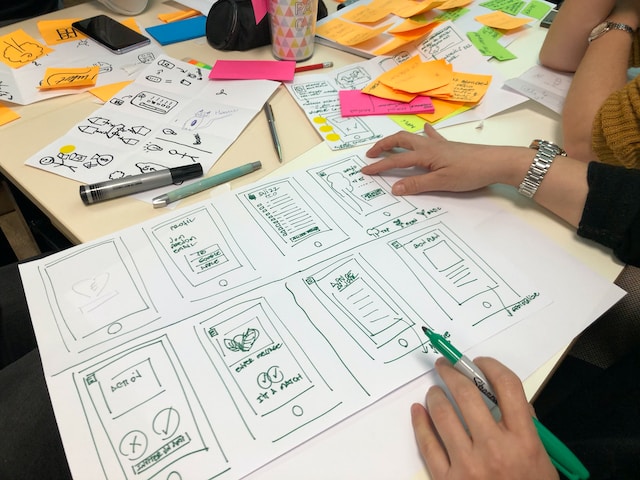
Photo by Amélie Mourichon on Unsplash
While UX and UI are often used interchangeably, they are distinct disciplines that work together to enhance users’ overall experience. Understanding the differences between UX and UI and their collaboration secrets can help developers, marketing managers, and digital managers create digital experiences that resonate with their target audience.
Unveiling the Mysteries of UX and UI
UX and UI are closely related but have distinct focuses within the digital design process. UX refers to users’ overall experience when interacting with a product, website, or application. It encompasses elements such as user research, information architecture, wireframing, and usability testing.
UI, on the other hand, is the visual component of the user experience. It includes the design elements that users interact with, such as buttons, menus, and graphics. UI designers focus on creating an interface that is visually appealing, intuitive, and user-friendly.
While UX and UI have different areas of focus, they are interdependent and should work in harmony to create a seamless user experience. UX research and testing provide valuable insights that inform UI design decisions, ensuring that the visual elements align with user needs and expectations.
The Secrets to Successful Collaboration
The collaboration between UX and UI professionals is key to creating a digital experience that delights users. Here are some secrets to successful teamwork:
1. Early and Constant Communication
UX and UI professionals should be involved in the design process from the beginning. By collaborating early on, they can align their goals, share insights, and make informed decisions prioritizing user needs. Constant communication throughout the design process ensures that any changes or updates are effectively communicated and implemented.
For example, UX and UI professionals can hold brainstorming sessions at the start of a project to discuss the project goals, target audience, and desired user experience. This early collaboration allows them to establish a shared understanding and vision for the project, setting the stage for successful cooperation and a unified design direction.
2. Clear Understanding of User Needs
Both UX and UI professionals should deeply understand the target audience and their needs. UX research provides insights into user behaviors, pain points, and motivations, which inform UI design decisions. UI professionals, in turn, should understand these insights and use them to create visually appealing and user-friendly interfaces.
For instance, UX researchers may conduct user interviews, surveys, and usability testing using various usability testing tools to gather data on user preferences and pain points. They can then share these findings with UI designers, who can incorporate them into their design decisions. By clearly understanding user needs, UX and UI professionals can work together to create designs tailored to their target audience.
3. Iterative Design Process
Collaboration between UX and UI professionals is an iterative process that involves constant feedback, testing, and refinement. The design should evolve based on user feedback and changing requirements. By continuously iterating and improving the design, UX and UI professionals can create a user experience that exceeds expectations.
As the design progresses, UX and UI professionals can conduct user testing to gather feedback on the usability and visual appeal of the interface. Based on this feedback, they can identify improvement areas and make iterative design updates. This iterative approach allows for ongoing collaboration between UX and UI professionals, ensuring that the final product meets user needs and exceeds their expectations.
4. Shared Ownership
Successful collaboration between UX and UI professionals requires shared ownership of the project. Both disciplines should be involved in decision-making and have a voice in the design direction. By fostering a sense of shared ownership, the team can collaborate effectively and create a cohesive user experience.
To foster shared ownership, UX and UI professionals can participate in collaborative design workshops or design sprints. These sessions allow for cross-functional collaboration and enable both disciplines to contribute their expertise and ideas. By including both UX and UI professionals in the decision-making process, the team can create a sense of shared ownership and ensure that the design reflects both disciplines’ combined insights and expertise.
5. Empathy and User-Centric Design
Both UX and UI professionals should have empathy for the end-users. They should prioritize user needs and create designs that are intuitive, accessible, and visually engaging. By adopting a user-centric approach to design, UX and UI professionals can create digital experiences that resonate with the target audience.
One way to foster empathy is by conducting empathy mapping exercises, where UX and UI professionals put themselves in the shoes of the users better to understand their needs, emotions, and motivations. This exercise helps them better understand the user’s perspective and informs their design decisions. By prioritizing empathy and user-centered design, UX and UI professionals can create digital experiences that truly meet user needs and exceed their expectations.
Conclusion
The collaboration between UX and UI professionals is vital to creating digital experiences that captivate users. By understanding the differences between the two disciplines and embracing their collaboration secrets, developers, marketing managers, and digital managers can ensure that their websites and applications are user-centered, visually appealing, and intuitive.
Whether you’re engaging freelancers or consultants or developing an in-house team, it’s essential to acknowledge the significant potential of the seamless collaboration between UX and UI within the digital landscape. By promoting effective teamwork, utilizing user insights, and embracing empathetic and user-focused design approaches, you have the opportunity to create digital experiences that not only fulfill user needs but also exceed their expectations.
